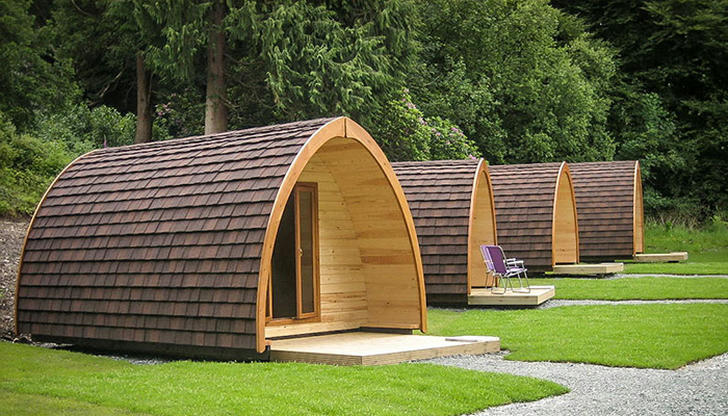Eco-Friendly Accommodations: Finding Sustainable Stays for Your Next Trip
As travelers become more conscious of their environmental impact, eco-friendly accommodations are gaining popularity. Choosing sustainable stays not only reduces your carbon footprint but also supports businesses that prioritize environmental and social responsibility. Whether you're traveling for leisure or business, making informed choices about where you stay can contribute to a greener planet. This guide will help you understand what makes an accommodation eco-friendly and provide practical tips on finding the best sustainable stays for your next trip.

I. What Makes an Accommodation Eco-Friendly?
1. Energy Efficiency and Renewable Energy Use
Eco-friendly accommodations reduce energy consumption by using energy-efficient appliances, LED lighting, and smart thermostats. Many sustainable hotels generate their own electricity through solar panels, wind turbines, or hydroelectric power. When booking a stay, check whether the property uses renewable energy sources or has implemented measures to reduce energy waste.
2. Water Conservation Efforts
Sustainable stays prioritize water conservation through features such as low-flow showerheads, dual-flush toilets, and rainwater harvesting systems. Some accommodations also treat and recycle wastewater for irrigation and other uses. Look for properties that actively promote water-saving initiatives.
3. Sustainable Building Materials and Design
Green accommodations are often built using sustainable materials such as bamboo, reclaimed wood, and recycled metal. Many hotels and lodges incorporate natural ventilation and passive solar heating to reduce their reliance on artificial cooling and heating. If possible, choose properties that have received green building certifications like LEED (Leadership in Energy and Environmental Design).
4. Waste Management and Plastic Reduction
Eco-friendly hotels and lodges implement waste reduction strategies, such as composting food scraps, recycling materials, and eliminating single-use plastics. Many properties encourage guests to use refillable water bottles and provide biodegradable toiletries instead of disposable plastic ones.
5. Locally Sourced and Organic Food
Sustainable accommodations often source their food locally to reduce carbon emissions associated with transportation. Some operate their own organic farms, while others partner with local farmers to serve fresh, seasonal ingredients. Look for hotels and resorts that offer farm-to-table dining or use Fair Trade and organic products.
6. Support for Local Communities and Ethical Practices
True sustainability goes beyond environmental concerns. Many eco-friendly accommodations support local communities by hiring local staff, funding community projects, and preserving cultural heritage. When choosing a stay, consider its ethical policies and how it contributes to local development.
II. How to Find Eco-Friendly Accommodations

1. Look for Green Certifications
Several global and regional organizations certify eco-friendly accommodations based on sustainability standards. When booking a stay, check for the following certifications:
LEED Certification – Recognizes energy-efficient and sustainable building design.
Green Key – Awards hotels that implement eco-friendly practices.
EarthCheck – Focuses on environmental and social responsibility in tourism.
Rainforest Alliance Certified – Ensures sustainability in lodges and resorts, especially in tropical regions.
Biosphere Certification – Recognizes sustainable tourism businesses worldwide.
2. Use Sustainable Travel Platforms
Several travel websites specialize in eco-friendly accommodations, making it easier to find sustainable stays. Some popular platforms include:
EcoHotels.com – Lists environmentally responsible hotels and lodges.
BookDifferent – Provides sustainability ratings for hotels.
Green Pearls – Focuses on boutique hotels with eco-friendly initiatives.
Airbnb’s "Green Stays" – Features eco-conscious listings with sustainability efforts.
3. Read Guest Reviews and Sustainability Reports
Before booking, read reviews from other travelers on platforms like TripAdvisor and Google Reviews. Look for mentions of energy-saving measures, recycling programs, and ethical business practices. Some hotels also publish sustainability reports detailing their environmental and social impact, which can help you make an informed decision.
4. Check the Hotel’s Website for Eco Initiatives
Visit the official website of your chosen accommodation and look for sections dedicated to sustainability. Many eco-friendly hotels outline their green policies, such as energy use, waste management, and community involvement. If this information isn’t available, consider reaching out to the hotel directly to ask about their environmental practices.
5. Choose Small, Locally Owned Eco-Lodges or Resorts
Rather than staying in large international hotel chains, consider locally owned eco-lodges, hostels, and boutique hotels that implement green practices. These accommodations are more likely to be engaged in environmental conservation and community support.
III. How to Make Your Stay More Sustainable

1. Reduce Water and Energy Usage
Even when staying at an eco-friendly hotel, you can further reduce your impact by:
Taking shorter showers.
Turning off lights, air conditioning, and electronics when not in use.
Reusing towels and linens instead of requesting daily replacements.
2. Minimize Waste and Plastic Consumption
Help reduce waste by:
Carrying a reusable water bottle and coffee cup.
Avoiding disposable toiletries and using your own eco-friendly personal care products.
Properly sorting and disposing of waste in recycling bins provided by the hotel.
3. Support Local Businesses and Ethical Tourism
Make a positive impact by:
Eating at locally owned restaurants instead of international chains.
Purchasing handmade souvenirs from artisans rather than mass-produced items.
Participating in tours run by local guides to support the community’s economy.
4. Respect Nature and Local Culture
If your accommodation is in a natural area, follow responsible travel practices such as:
Avoiding disturbance to wildlife and protected habitats.
Sticking to marked trails when hiking to minimize environmental damage.
Learning about local customs and respecting cultural traditions.
IV. Examples of Eco-Friendly Accommodations Worldwide

1. Soneva Fushi (Maldives)
A luxury eco-resort that runs on solar power, recycles waste, and actively supports marine conservation.
2. Whitepod Eco-Luxury Hotel (Switzerland)
A unique stay featuring geodesic dome pods that use minimal energy and blend seamlessly into the natural landscape.
3. Lapa Rios Lodge (Costa Rica)
A rainforest ecolodge that promotes wildlife conservation and supports local communities.
4. The Green House (United Kingdom)
An award-winning eco-hotel that uses sustainably sourced materials, energy-efficient systems, and organic food.
5. Song Saa Private Island (Cambodia)
A luxury eco-resort dedicated to sustainability, marine conservation, and responsible tourism.
V. Conclusion
Choosing eco-friendly accommodations is one of the most impactful ways to reduce your environmental footprint while traveling. By considering energy efficiency, waste management, water conservation, and community support, you can make responsible choices that benefit both the planet and local economies. With the right research and mindful travel habits, you can enjoy a sustainable and rewarding stay, knowing that your travels are contributing to a greener future.
